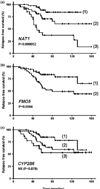Relationship between intratumoral expression of genes coding for xenobiotic-metabolizing enzymes and benefit from adjuvant tamoxifen in estrogen receptor alpha-positive postmenopausal breast carcinoma
- PMID: 15084249
- PMCID: PMC400681
- DOI: 10.1186/bcr784
Relationship between intratumoral expression of genes coding for xenobiotic-metabolizing enzymes and benefit from adjuvant tamoxifen in estrogen receptor alpha-positive postmenopausal breast carcinoma
Abstract
Introduction: Little is known of the function and clinical significance of intratumoral dysregulation of xenobiotic-metabolizing enzyme expression in breast cancer. One molecular mechanism proposed to explain tamoxifen resistance is altered tamoxifen metabolism and bioavailability.
Methods: To test this hypothesis, we used real-time quantitative RT-PCR to quantify the mRNA expression of a large panel of genes coding for the major xenobiotic-metabolizing enzymes (12 phase I enzymes, 12 phase II enzymes and three members of the ABC transporter family) in a small series of normal breast (and liver) tissues, and in estrogen receptor alpha (ERalpha)-negative and ERalpha-positive breast tumors. Relevant genes were further investigated in a well-defined cohort of 97 ERalpha-positive postmenopausal breast cancer patients treated with primary surgery followed by adjuvant tamoxifen alone.
Results: Seven of the 27 genes showed very weak or undetectable expression in both normal and tumoral breast tissues. Among the 20 remaining genes, seven genes (CYP2A6, CYP2B6, FMO5, NAT1, SULT2B1, GSTM3 and ABCC11) showed significantly higher mRNA levels in ERalpha-positive breast tumors than in normal breast tissue, or showed higher mRNA levels in ERalpha-positive breast tumors than in ERalpha-negative breast tumors. In the 97 ERalpha-positive breast tumor series, most alterations of these seven genes corresponded to upregulations as compared with normal breast tissue, with an incidence ranging from 25% (CYP2A6) to 79% (NAT1). Downregulation was rare. CYP2A6, CYP2B6, FMO5 and NAT1 emerged as new putative ERalpha-responsive genes in human breast cancer. Relapse-free survival was longer among patients with FMO5-overexpressing tumors or NAT1-overexpressing tumors (P = 0.0066 and P = 0.000052, respectively), but only NAT1 status retained prognostic significance in Cox multivariate regression analysis (P = 0.0013).
Conclusions: Taken together, these data point to a role of genes coding for xenobiotic-metabolizing enzymes in breast tumorigenesis, NAT1 being an attractive candidate molecular predictor of antiestrogen responsiveness.
Figures


References
-
- McGuire WL. Steroid hormone receptors in breast cancer treatment strategy. Recent Prog Horm Res. 1980;36:135–156. - PubMed
Publication types
MeSH terms
Substances
LinkOut - more resources
Full Text Sources
Other Literature Sources
Medical
Research Materials

